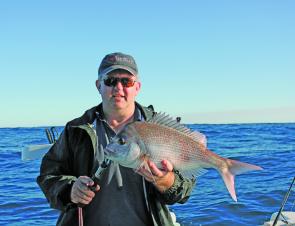What a winter season we are enjoying on the Sunshine Coast with an abundance of fish right across the many reef systems.
Winter traditionally brings with it hopes of quality snapper and pearl perch and the fishing times are better suited to early mornings and late afternoons, before the wind comes on. The cool weather can also bring millpond conditions in the afternoons making boating a pleasure and the fishing even better.
Most of the inner reefs have fired and pearl perch have been around in numbers. Along with quality snapper, pearl perch from 2-4kg are common within the Gneerings and Caloundra 7 and 12 Mile reefs. Murphys is still giving up a wide range of species with a few surprises mixed in amongst them.
Out wide, particularly around the 60-80m marks at Wide Caloundra and the top of the Barwon Banks, anglers have enjoyed good sessions on mixed reefies and one of the best seasons on teraglin (jew) that I have enjoyed for years. The average size for the teraglin being taken at the moment is 65-75cm, making them a good target for the table.
Fishing a morning or early afternoon high tide out wide is the way to target the pearl perch, tuskfish, red throat and snapper. When the tide is in the middle of nowhere then move to shallow reefs approx 40m and drift for pelagics, parrot and amberjack.
The shallow reefs are also the spot to try your jigs for pelagics or your 7” soft plastics. Plenty of sweetlip have fallen to them in the past. The bottom of the Hards is the place for amberjack and these tough fighters are generally around the wire weed areas as they love to munch on small pearl perch. Amberjack are a hard but clean fighting fish that will test any angler and gear alike.
Fishing out wide in over 60m I use around 50lb braid, particularly if there is a current running. The 50lb allows you to put a fair lead size on and still has the integrity to muscle up a couple of large fish on either a paternoster or a simple snell rig. The key to catching more fish is to use the lightest possible line and least amount of weight. If the current allows, I will use only 6-10oz of lead in 60-90m of water. It may take longer to get down but you will pick up a lot more in the long run.
Good skippers are also the key to holding on the spot while your line is racing to the bottom. In half reasonable conditions the skipper can keep the boat over the mark long enough for you to hook up. Of course there are many variables, like wind, tide and current, that can make it near on impossible but there are always alternatives to heavy fishing and that’s where good information and a well planned day will always come out on top. The best reward for anglers is to put on the agenda three or four different backup ideas but never make it to the second one because you have caught so many fish!
The beaches are the best target area for big mulloway and tailor at the moment with a stack being caught up around Noosa North Shore. The Wurtulla strip is ok but without the formation of really good gutters the majority of fish don’t make it into the holes around the place. Work closer to the rocks for the mulloway or stay up into the night just off the deeper channels to get the bigger fish.
Plenty of mullet are about in the estuaries along with some monster herring and a few scattered schools of winter whiting all of which make great mulloway baits. I have enjoyed recent success on my Damiki blades and 3” soft plastics on the tailor, but waiting for them to break the surface while feeding can get a little tedious. The best thing to do is work the river mouths and around the pontoons and jetties because if the bait is there, the bigger fish will be eventually.
The Blue Hole has come into its own recently with the deep hole stretching along the final northern area of Bribie Island. There are some monster bream in there and they are well worth a crack in the wee hours of the morning or evenings on corresponding tides. Live worms are the absolute gun bait on these monsters with hardihead and herring next pick.
Tarwhine are around Bulcock Beach in Caloundra right through to Happy Valley. Remember to use as small a weight as you can and walk with the current flow until you hook up. There are plenty of scattered rocks and bommies which are well hidden that can snag you up unless you are careful.
The winter whiting are also in numbers south from Bells Creek through to Coochin Creek. It’s not hard to tell where the locals are when you see them in big groups around the place. Sadly many anglers fall for the trick that if there are so many boats around they must be catching fish. The truth normally is that nobody really knows what they are doing and hoping someone else does. Don’t be scared to try different spots that you think will work and test them out over different tides and time until you know when it fires. That is what fishing smart is all about.
Have Fun!
Reads: 2431
Damien with a typical size pearl perch. Most of the inner reefs have fired and pearl perch have been around in numbers.

Pan size snapper are the best for eating. For quality snapper, times are better suited to early mornings and late afternoons, before the wind comes on.

When the tide is in the middle move to the shallow reefs and drift for parrotfish.

Quality snapper are common within the Gneerings and Caloundra 7 and 12 Mile reefs.




